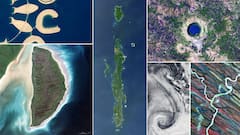COP 15: Landmark UN Biodiversity Deal Reached To Protect 30% Lands, Cut Food Waste, And More By 2030
COP 15: The UN Biodiversity Agreement aims to protect 30 per cent of Earth's lands, coastal areas and inland waters by 2030. It also intends to cut food waste in half by 2030.

COP 15: The United Nations (UN) Biodiversity Conference in Montreal, Canada, that began on December 7, 2022, and will conclude on Tuesday, December 20 with a 'landmark' agreement. A day before the conference ends, about 190 nations adopted four goals and 23 targets to be achieved by 2030.
The Secretariat of Convention on Biological Diversity announced on Twitter on Monday, December 19 the goals and targets of the UN Biodiversity Agreement, known as the Global Biodiversity Framework.
🚨#BreakingNews: Nations Adopt 4 Goals, 23 Targets for 2030 In Landmark UN Biodiversity Agreement
— UN Biodiversity (@UNBiodiversity) December 19, 2022
By 2030: Protect 30% of 🌏's lands, 🌊, coastal areas, inland waters; Cut food waste in half’; More
📄➡️ https://t.co/wzlD2ivPKD#COP15 #COP15Announcement #GBFAdoption #post2020🌱 pic.twitter.com/d4gQgJ4zIk
Goals and targets of the UN Biodiversity Agreement
The agreement aims to protect 30 per cent of Earth's lands, coastal areas and inland waters by 2030. It also intends to cut food waste in half by 2030.
The aim of the deal is to ensure effective conservation and management of at least 30 per cent of the world's lands, inland waters, coastal areas and oceans by 2030, with emphasis on areas of particular importance for biodiversity and ecosystem functioning and services.
The UN Biodiversity Agreement also aims to have restoration completed or underway on at least 30 per cent of degraded terrestrial, inland waters, and coastal and marine ecosystems, by 2030.
Another target is to reduce to near zero the loss of areas of high biodiversity importance, including ecosystems of high ecological integrity by 2030.
The deal also aims to reduce by half both excess nutrients and the overall risk posed by pesticides and highly hazardous chemicals by 2030.
Another aim of the agreement is to progressively phase out or reform by 2030 subsidies that harm biodiversity by at least $500 billion per year. At the same time, the team intends to scale up positive incentives for the conservation of biodiversity and its sustainable use.
The nations who adopted the deal aim to mobilise by 2030 at least $200 billion per year in domestic and international biodiversity-related funding from all sources, public as well as private.
The nations also intend to raise international financial flows from developed to developing countries, in particular least developed countries, small island developing States, and countries with economies in transition, to at least US $20 billion per year by 2025, and to at least US $30 billion per year by 2030.
The agreement aims to prevent the introduction of priority invasive alien species, and reduce by at least half the introduction and establishment of other known or potentially invasive alien species. It also plans to eradicate or control invasive alien species on islands and other priority sites.
The deal aims to cut global food waste in half and significantly reduce overconsumption and waste generation by 2030.
The deal will require large and translational companies and financial institutions to monitor, assess and transparently disclose their risks, dependencies and impacts on biodiversity through their portfolios of operations, supply and value chains.
The agreement represents the most significant effort to protect the world's lands and oceans and provide critical financing to save biodiversity in the developing world, according to a report by the Associated Press (AP). Currently, 17 per cent of terrestrial areas and 10 per cent of marine areas are protected, the report said.
What world leaders and environmentalists say about the deal
Andrew Deutz, director of global policy, institutions and conservation finance for The Nature Conservancy, said the new text is a mixed bag, and contains some strong signals on finance and biodiversity, but fails to advance beyond the targets of 10 years ago in terms of addressing drivers of biodiversity loss in productive sectors like agriculture, fisheries and infrastructure.
Leaders from about 190 countries have agreed that protecting biodiversity has to be a priority. Many ministers and government officials from the countries that participated in COP 15 have compared the efforts to climate talks held in COP27 in Sharm El-Sheikh, Egypt.
The world's biodiversity has been affected due to climate change, habitat loss, and pollution. In 2019, an estimate warned that a million plant and animal species faced extinction within decades, the AP report said. This is a rate of loss 1,000 times greater than expected.
One of the most important topics that took centrestage at COP 15 is financing to reverse the loss of biodiversity, and deciding who will pay for it.
The agreement recognises the rights of indigenous communities, something which was ignored in past biodiversity documents. Indigenous communities and rights were rarely a part of the larger discussions, and only their traditional knowledge was given importance. According to the AP report, Jennifer Corpuz, a representative of the International Forum on Biodiversity, said it is important for the rights of indigenous people to be there.
However, the Wildlife Conservation Society and other environmental groups were concerned that the draft deal puts off the goal of preventing the extinction of species, maintaining genetic diversity within populations, and preserving the integrity of ecosystems, until 2050.
Trending News
Top Headlines








































